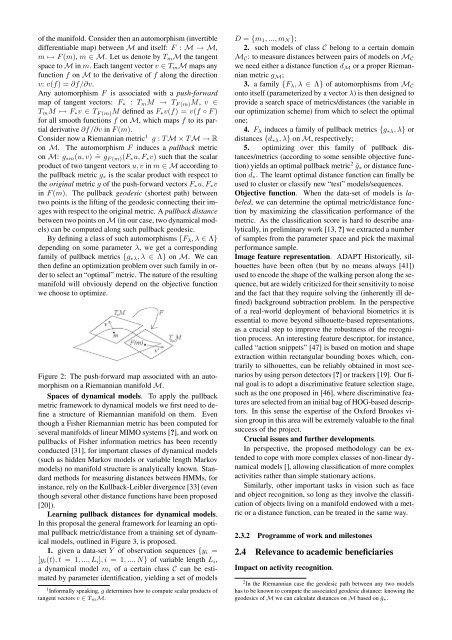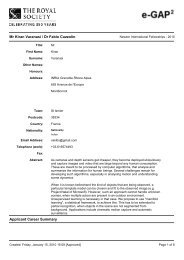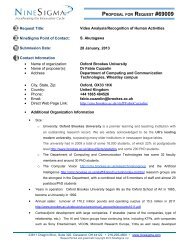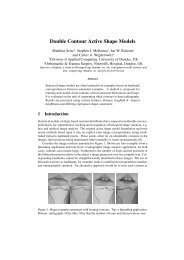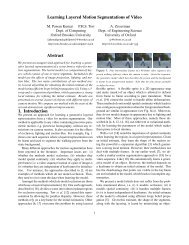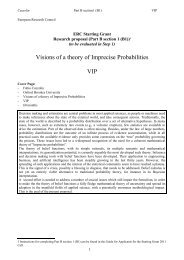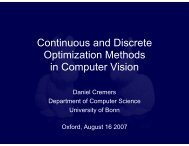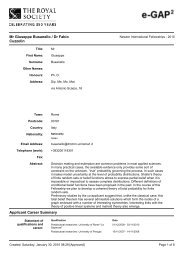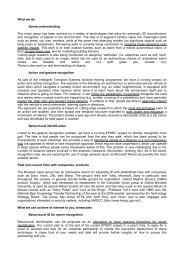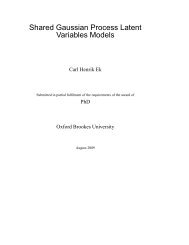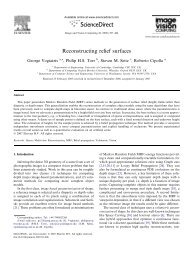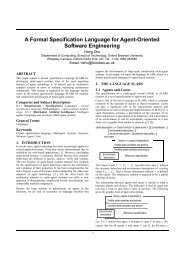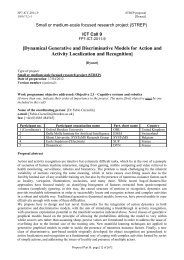Learning manifolds of dynamical models for activity recognition
Learning manifolds of dynamical models for activity recognition
Learning manifolds of dynamical models for activity recognition
Create successful ePaper yourself
Turn your PDF publications into a flip-book with our unique Google optimized e-Paper software.
<strong>of</strong> the manifold. Consider then an automorphism (invertible<br />
differentiable map) between M and itself: F : M → M,<br />
m ↦→ F (m), m ∈ M. Let us denote by TmM the tangent<br />
space to M in m. Each tangent vector v ∈ TmM maps any<br />
function f on M to the derivative <strong>of</strong> f along the direction<br />
v: v(f) = ∂f/∂v.<br />
Any automorphism F is associated with a push-<strong>for</strong>ward<br />
map <strong>of</strong> tangent vectors: F∗ : TmM → T F (m)M, v ∈<br />
TmM ↦→ F∗v ∈ T F (m)M defined as F∗v(f) = v(f ◦ F )<br />
<strong>for</strong> all smooth functions f on M, which maps f to its partial<br />
derivative ∂f/∂v in F (m).<br />
Consider now a Riemannian metric 1 g : T M × T M → R<br />
on M. The automorphism F induces a pullback metric<br />
on M: g∗m(u, v) . = g F (m)(F∗u, F∗v) such that the scalar<br />
product <strong>of</strong> two tangent vectors u, v in m ∈ M according to<br />
the pullback metric g∗ is the scalar product with respect to<br />
the original metric g <strong>of</strong> the push-<strong>for</strong>ward vectors F∗u, F∗v<br />
in F (m). The pullback geodesic (shortest path) between<br />
two points is the lifting <strong>of</strong> the geodesic connecting their images<br />
with respect to the original metric. A pullback distance<br />
between two points on M (in our case, two <strong>dynamical</strong> <strong>models</strong>)<br />
can be computed along such pullback geodesic.<br />
By defining a class <strong>of</strong> such automorphisms {Fλ, λ ∈ Λ}<br />
depending on some parameter λ, we get a corresponding<br />
family <strong>of</strong> pullback metrics {g∗λ, λ ∈ Λ} on M. We can<br />
then define an optimization problem over such family in order<br />
to select an “optimal” metric. The nature <strong>of</strong> the resulting<br />
manifold will obviously depend on the objective function<br />
we choose to optimize.<br />
Figure 2: The push-<strong>for</strong>ward map associated with an automorphism<br />
on a Riemannian manifold M.<br />
Spaces <strong>of</strong> <strong>dynamical</strong> <strong>models</strong>. To apply the pullback<br />
metric framework to <strong>dynamical</strong> <strong>models</strong> we first need to define<br />
a structure <strong>of</strong> Riemannian manifold on them. Even<br />
though a Fisher Riemannian metric has been computed <strong>for</strong><br />
several <strong>manifolds</strong> <strong>of</strong> linear MIMO systems [?], and work on<br />
pullbacks <strong>of</strong> Fisher in<strong>for</strong>mation metrics has been recently<br />
conducted [31], <strong>for</strong> important classes <strong>of</strong> <strong>dynamical</strong> <strong>models</strong><br />
(such as hidden Markov <strong>models</strong> or variable length Markov<br />
<strong>models</strong>) no manifold structure is analytically known. Standard<br />
methods <strong>for</strong> measuring distances between HMMs, <strong>for</strong><br />
instance, rely on the Kullback-Leibler divergence [33] (even<br />
though several other distance functions have been proposed<br />
[20]).<br />
<strong>Learning</strong> pullback distances <strong>for</strong> <strong>dynamical</strong> <strong>models</strong>.<br />
In this proposal the general framework <strong>for</strong> learning an optimal<br />
pullback metric/distance from a training set <strong>of</strong> <strong>dynamical</strong><br />
<strong>models</strong>, outlined in Figure 3, is proposed.<br />
1. given a data-set Y <strong>of</strong> observation sequences {yi =<br />
[yi(t), t = 1, ..., Li], i = 1, ..., N} <strong>of</strong> variable length Li,<br />
a <strong>dynamical</strong> model mi <strong>of</strong> a certain class C can be estimated<br />
by parameter identification, yielding a set <strong>of</strong> <strong>models</strong><br />
1 In<strong>for</strong>mally speaking, g determines how to compute scalar products <strong>of</strong><br />
tangent vectors v ∈ TmM.<br />
D = {m1, ..., mN};<br />
2. such <strong>models</strong> <strong>of</strong> class C belong to a certain domain<br />
MC: to measure distances between pairs <strong>of</strong> <strong>models</strong> on MC<br />
we need either a distance function dM or a proper Riemannian<br />
metric gM;<br />
3. a family {Fλ, λ ∈ Λ} <strong>of</strong> automorphisms from MC<br />
onto itself (parameterized by a vector λ) is then designed to<br />
provide a search space <strong>of</strong> metrics/distances (the variable in<br />
our optimization scheme) from which to select the optimal<br />
one;<br />
4. Fλ induces a family <strong>of</strong> pullback metrics {g∗λ, λ} or<br />
distances {d∗λ, λ} on M, respectively;<br />
5. optimizing over this family <strong>of</strong> pullback distances/metrics<br />
(according to some sensible objective function)<br />
yields an optimal pullback metric 2 ˆg∗ or distance function<br />
ˆ d∗. The learnt optimal distance function can finally be<br />
used to cluster or classify new “test” <strong>models</strong>/sequences.<br />
Objective function. When the data-set <strong>of</strong> <strong>models</strong> is labeled,<br />
we can determine the optimal metric/distance function<br />
by maximizing the classification per<strong>for</strong>mance <strong>of</strong> the<br />
metric. As the classification score is hard to describe analytically,<br />
in preliminary work [13, ?] we extracted a number<br />
<strong>of</strong> samples from the parameter space and pick the maximal<br />
per<strong>for</strong>mance sample.<br />
Image feature representation. ADAPT Historically, silhouettes<br />
have been <strong>of</strong>ten (but by no means always [41])<br />
used to encode the shape <strong>of</strong> the walking person along the sequence,<br />
but are widely criticized <strong>for</strong> their sensitivity to noise<br />
and the fact that they require solving the (inherently ill defined)<br />
background subtraction problem. In the perspective<br />
<strong>of</strong> a real-world deployment <strong>of</strong> behavioral biometrics it is<br />
essential to move beyond silhouette-based representations,<br />
as a crucial step to improve the robustness <strong>of</strong> the <strong>recognition</strong><br />
process. An interesting feature descriptor, <strong>for</strong> instance,<br />
called “action snippets” [47] is based on motion and shape<br />
extraction within rectangular bounding boxes which, contrarily<br />
to silhouettes, can be reliably obtained in most scenarios<br />
by using person detectors [?] or trackers [19]. Our final<br />
goal is to adopt a discriminative feature selection stage,<br />
such as the one proposed in [46], where discriminative features<br />
are selected from an initial bag <strong>of</strong> HOG-based descriptors.<br />
In this sense the expertise <strong>of</strong> the Ox<strong>for</strong>d Brookes vision<br />
group in this area will be extremely valuable to the final<br />
success <strong>of</strong> the project.<br />
Crucial issues and further developments.<br />
In perspective, the proposed methodology can be extended<br />
to cope with more complex classes <strong>of</strong> non-linear <strong>dynamical</strong><br />
<strong>models</strong> [], allowing classification <strong>of</strong> more complex<br />
activities rather than simple stationary actions.<br />
Similarly, other important tasks in vision such as face<br />
and object <strong>recognition</strong>, so long as they involve the classification<br />
<strong>of</strong> objects living on a manifold endowed with a metric<br />
or a distance function, can be treated in the same way.<br />
2.3.2 Programme <strong>of</strong> work and milestones<br />
2.4 Relevance to academic beneficiaries<br />
Impact on <strong>activity</strong> <strong>recognition</strong>.<br />
2 In the Riemannian case the geodesic path between any two <strong>models</strong><br />
has to be known to compute the associated geodesic distance: knowing the<br />
geodesics <strong>of</strong> M we can calculate distances on M based on ˆg∗.


